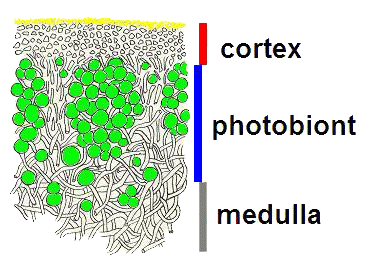
Just like Patrick discovering the presence of foreign organisms living in his rock, we must find out what these lichen are.
Lichen are not just a singular organism, but are formed from a symbiotic relationship between a fungus and algae or cyanobacteria. A lichen’s thallus structure consists of different layers of algae and fungus called the cortex, photobiont, and medulla. The cortex is the outermost layer and acts like a protective skin. This layer consists of fungal hyphae that are closely packed together. Below the cortex is the photobiont layer, this is where the algae or cyanobacteria reside. Typically if the photobionat layer is algae a brighter green color will resonate from the lichen while a dark blueish-green color will come from a cyanobacteria. Finally, we get to the medulla, which is actually a majority of the lichen’s thallus. It consists of fungal filaments that are loosely packed into the middle and resemble loose threads.


Now that we have established these organisms are not aliens from another plant, we must find how they are able to stick to everything and anything in order to evict them from Patrick’s home.
Lichen attach using the one of two mechanisms: Rhizines or Holdfast. Rhinizines use multiple fungal filaments to attach to their surface while holdfast use a central peg to attach to theirs.
Here’s a video explaining the structure of the lichen
Now its time for Patrick to remove this organisms from his home

Interesting to learn that the cyanobacteria (photobiont layer) are covered by a layer of fungus despite them requiring sun exposure in order to properly photosynthesize. I wonder if this layer is a sort of mesh so as to allow light in while still retaining and protecting the vital layer of cyanobacteria? Would you happen to know if Rhizines and Holdfast are used for different types of surfaces? Perhaps Holdfast for wood, which is more easily penetrated, and Rhinzines for the surface of rocks?
Hey Austin,
Love the Patrick GIFs by the way. I’m actually happy that I stumbled upon your blog; Lichens are probably my favorite example of a symbiotic relationship. I definitely learned something new about them, like how they use two mechanisms to stick to a surface. Very cool stuff.
-Jenny Kong